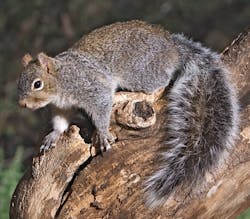Another Good Reason for Microgrids: Cyber Squirrel Operations are Climbing
Credit: www.naturespicsonline.com
Here’s another good reason for microgrids. Grid terrorists are hiding in your backyard behind cute furry faces. John Rogers of the Union of Concerned Scientists describes how we can win the cyber squirrel wars.
Some recent experiences with wildlife, and news about wildlife-electricity interactions, have me thinking about the risks of our dependence on the way things are. Our little furry friends may just be telling us that there are better ways to do things, including in the power sector.
Home on the range
Animals of the wild sort are on my mind because they’ve been in my life more visibly lately. Recently we’ve seen a possum and some fishers (members of the weasel family) in our yard, and a few weeks ago a curious and out-of-place young fox snarled my morning commute. Last month a raccoon moved into our chimney to use it for child-rearing.
But the possum and fishers stayed outside, the fox didn’t make me miss my train, and the raccoons were on the other side of a solid chimney damper (we couldn’t see each other, but my kids gave them names). And, maybe most importantly—given our need for electricity for cooking, cooling, fridging, and more—none of them disrupted our home electricity supply, and the lights stayed on.
Elsewhere, people (and animals) haven’t been so lucky. As it turns out, animals and our electricity interact a lot more than we may realize. Here are a few recent examples that have hit my inbox:
- A squirrel trespassing in an electrical substation left more than 4,000 customers without power in Muncie, Indiana, in March.
- Also in March, a raccoon “run[ning] amok” took out power at the Salt Lake City airport for an hour and a half.
- Another raccoon struck around Racine, Wisconsin, in May, knocking out power for several thousand customers.
A new website dedicated to tracking such incidents, CyberSquirrel1.com, has so far mapped 1,368 “successful” “Cyber Squirrel Operations” (and climbing…). Squirrels account for more than half of the take-downs they’ve found, followed by birds, raccoons, and snakes. (Even frogs get a piece of the action.)
It’s not just the U.S. homes and businesses under animal attack. In April a weasel took down the Large Hadron Collider, the (otherwise) very impressive particle accelerator, for days. And just last week a monkey knocked out power in all of Kenya for four hours.
As the Washington Post reported earlier this year, the Brookings Institution even uses animal incidents to put cybersecurity in context, with a Brookings expert saying that “squirrels have taken down the power grid more times than the zero times that hackers have.” CyberSquirrel1 quotes a former NSA official saying natural disaster and squirrels probably come ahead of cyberattacks in terms of threat.
None of that is to say that cyberattacks aren’t worth attention, but it’s important to put them in the broader context of threats to our power system as it’s currently configured.
Problems and solutions
So what’s a person (or household or city or particle accelerator manager) to do about all this? It comes down to realizing (1) that we’ve got problems and (2) that we’ve got solutions.
The idea that our power grid is increasingly not up to the challenges that face it has been the subject of a couple of recent Union of Concerned Scientists reports. Power Failure: How Climate Change Puts Our Electricity at Risk (2014) looked at a range of threats to our electrical grid from global warming impacts, from coastal flooding and drought to extreme heat and wildfires. Lights Out? Storm Surge, Blackouts, and How Clean Energy Can Help(2015) focused on the threats to coastal power infrastructure from flooding and sea level rise.
Good reason for microgrids
Those concepts—about the problems, and about the solutions—actually work pretty well for squirrel threats, too. The notion of incorporating onsite generation and energy storage, and a degree of capacity to operate independent of the larger electric grid, can serve people well. Our world is changing, and our power system should be changing, too. Fortunately, there are solutions. Lights Out? points to the power of resilient power, systems that are “flexible, can respond to challenges, can quickly recover, and remain available when we need [them] most.” It cites options including solar or wind systems with energy storage, combined heat and power/cogeneration systems, and microgrids. Clean energy options help both avoid climate change and prepare for it.
Ounces of prevention
I expect, if they could, the squirrel, weasel, and raccoon communities would vote for upgrades, not just for more resilience, but for prudent hardening—preventing incidents in the first place. Squirrels, the Washington Post has reported, “remain the biggest wildlife nemesis because of their sheer numbers and smarts,” but those “smarts” often get them into situations that end badly for them, not just power customers. (In the case of the weasel and the LHC, the “unfortunate creature did not survive the encounter.” The Kenyan monkey, though, did.)
And as for our little raccoon friends (Rachel, Rocky, Randy, and Ricky), the solution seemed to be encouraging momma to move out, and to take her babies with her. It didn’t end up going that smoothly. But the chimney is now capped, so our own little bit of hardening is in place.
Lots more ounces of prevention in our power choices could save a whole lot more pounds of problems. For us and our furry friends.
John Rogers is a UCS senior energy analyst. This blog originated on the UCS blog, The Equation.
